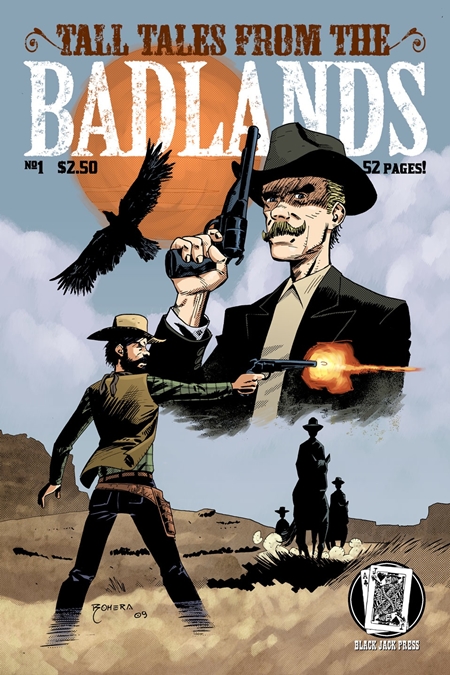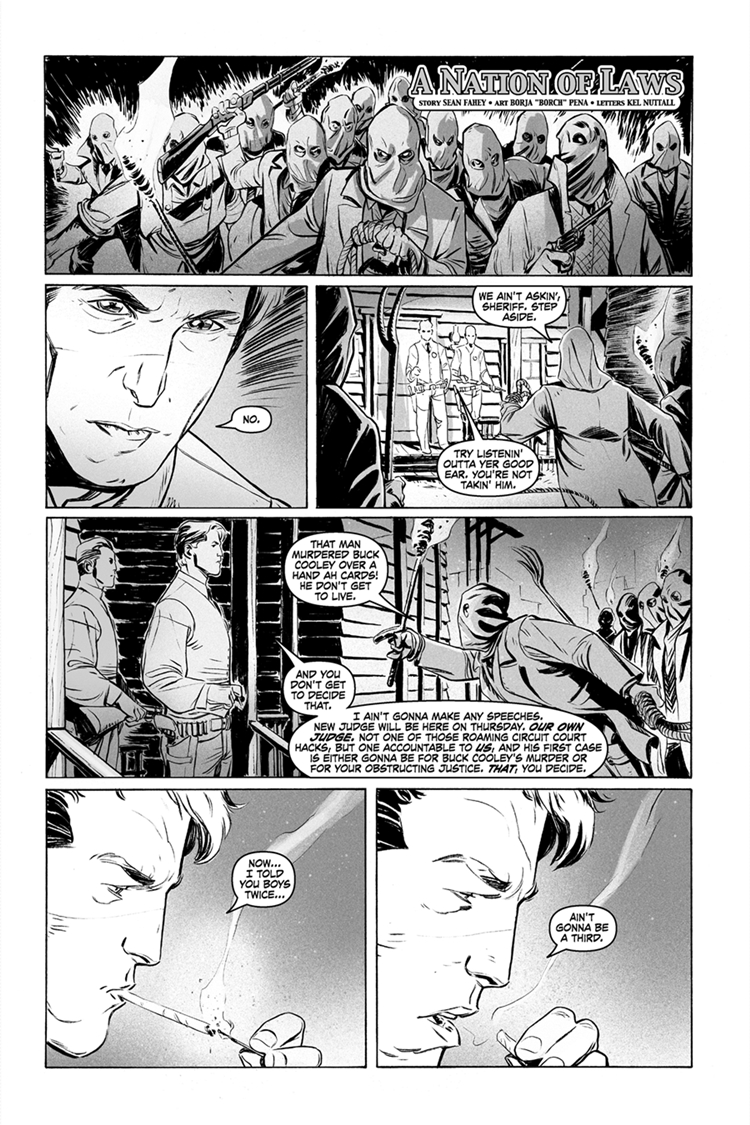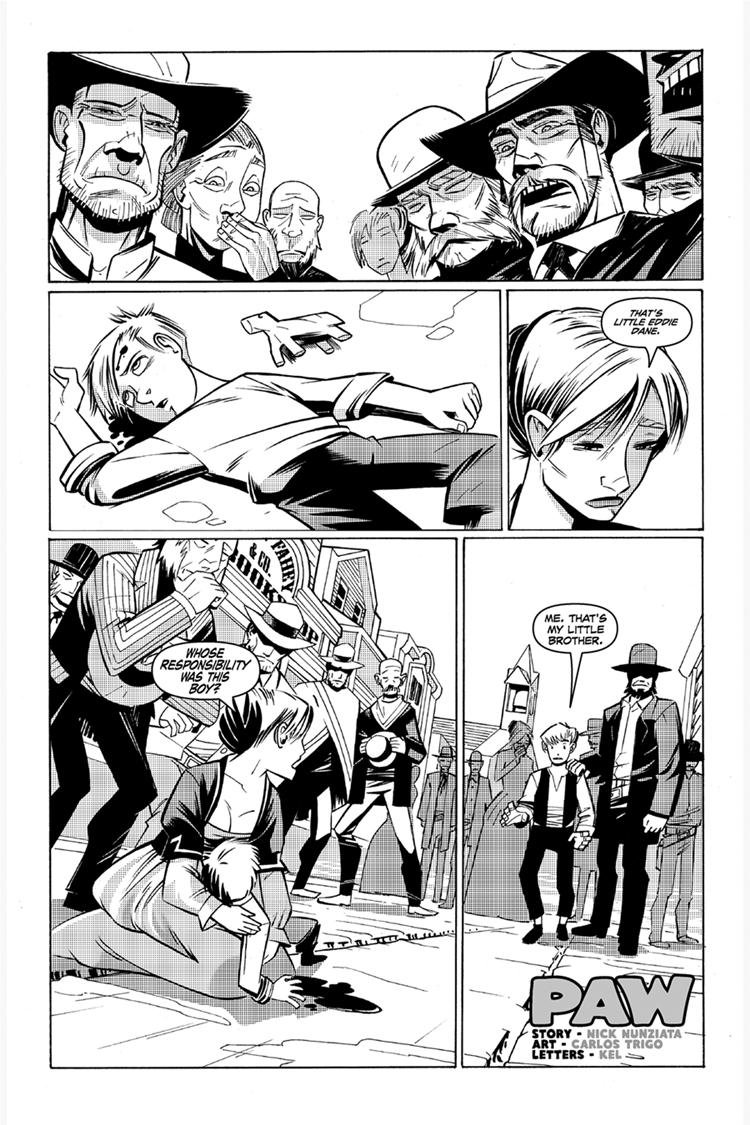
By Sean Fahey and Nick Nunziata
I love comic books. Love ‘em. Love reading ‘em, and I love writing ‘em. Like thousands of other kids, I wanted to make my own comics from a very early age. Tell my own stories. After thirty years of sitting on my ass wishing, I finally up and did it. Wrote a few stories, hired a few artists and put a cover on it. Simple as that. Few months later, I was holding a copy of the comic I put together with my bare hands in my…well, in my bare hands. Sold a few copies. Got some great write ups from sites like iFanboy, Broken Frontier and Ain’t It Cool, made a website for the book and had my product available in print and digitally for the world to see.
Now’s the hard part…doing it again.
I’m smack dab in the middle of putting together the second issue of my self-published Western anthology series, Tall Tales from the Badlands, and am learning as much about self-publication this time around as I did the first time. Got me thinking. I figured that there are a lot of people out there in the exact same position I was a few years ago — very eager to tell stories they felt passionate about and willing to do whatever it takes to make their own comic book…but having absolutely no idea how to functionally make that happen. The next epic Western is out there. The next thrill-a-minute sword and sorcery saga is just waiting to be told, as is the next clever hardboiled crime story, spine-tingling supernatural thriller and thought provoking war story. If there was anyway I could nudge one of those storytellers toward the keyboard, I wanted to do it. I kinda wanted to “pay it forward,” but in a detailed soup-to-nuts way. Not stop at “The best way to break into comics is to make your own comics. Next question” chestnut you hear over and over again at most (but not all) comic book convention panels.
Before I begin, two things. First, I’m not special. There’s nothing that I’ve done in comics that thousands of other folks haven’t done, most of which much better than I. I guess the only special thing special about my experience is that – unlike tens of thousands of other folks – I was too dumb to quit. Second, my experience is just one way out of many to get your own comic book made, but it’s one that I plan to go over in enough detail to replicate (should anyone so desire).
Alright, enough hot air. Tall Tales from the Badlands Production Journal – Part One. Right now, we’re in the middle of production for issue two, and laying some foundational groundwork for issue three. Issue number two (like issue one) will have five stories, and all the scripts are in. As the title of our anthology suggests, all of the stories are Westerns. Probably a good time here to talk a little about FORMAT, which is really one of the first critical decision points in the self-publication journey. After two failed attempts (I could try and make myself feel better and say “stalled,” but lets be honest) to publish an “epic” multi-part comic book extravaganza (one a Viking space-opera – yes, you read that right – the other a Western about the last battle of the Civil War), I came to the same humbling conclusion that smarter folks than I knew much earlier in their respective journeys — you have to learn how to walk before you can run. Thanks, Captain Cliche, what does that actually mean? It means that it’s easier to write an eight page story than it is to write a one hundred and twenty page story. It means that it’s easier to keep the attention of an artist you just met online for an eight page project than it is for a one hundred and twenty page project, and it means that there is strength in numbers. In large part because of these principles, the first successful comic book project I had was an ANTHOLOGY, and the anthology format is one that I would recommend as the starting point for any aspiring comic book creator to launch their career.
I could talk at length about the advantages of choosing an anthology as your first self-published comic book project. For our purpose here, I’ll focus on three points. First, and as suggested above, the likelihood of FINISHING what you start is much higher with an anthology than a mini-series or graphic novel. Most single issue (floppy)anthologies are no more than four or five stories long, and the average page length is eight, maybe ten, pages. Find a good group of aspiring creators and your initial commitment could be as little as eight to ten pages. If you can’t write an eight page story then you’re not serious or passionate about telling stories. Period.
Second, making comics – good comics – is expensive. Trust me, unless you have a relationship with an artist that you want to work with, for your initial foray into comics you want the best artist you can afford to hire. Period. The fact that I’ve been lucky enough to work with amazing, professional level quality artists has helped mask the fact that I’m an amateur behind the keyboard. No one is Brian Azzarello on their first try. Brian Azzarello wasn’t Brian Azzarello on his first try. You need time to develop (and you need to be committed to developing), but let’s face it, the only way to get better is to actually do it – not just write it – but work the entire process out from story concept to finished page. Point being, a good artist is worth every penny during this developmental period, and if your total FINANCIAL commitment to a project is eight pages vice one hundred and twenty…well, you don’t need a calculator to figure it out.
Finally, it’s nice to have some support on this journey. If you’re like me, you have a day job, probably a family too, and not a lot of free time. Going through this journey with FRIENDS makes all the difference. You pull for each other. You share drafts, pass notes, critique, motivate. You act as each other’s sounding boards and cheerleading section. Leaving aside the five artists that I worked with, I did not finish the first issue of “Tall Tales from the Badlands” by myself. My brother Seamus wrote two of the stories, and we passed versions of our stories back and forth throughout the process. I can say without hesitation that each of my stories improved significantly as a result of this (90% of writing really is in the editing — Captain Cliche strikes again!). I paid for my artists. He paid for his. We pushed each other when one of was dragging our ass. That said, we did have a secret weapon — Dave Davis, who we appointed as our editor. Many a phone call was had about directions for stories and how to physically put this comic together, which Dave basically did singlehandedly. Tall Tales just would not exist without him. Having a few projects under my belt now, I feel more confident in my ability to get things done, but on that first project…well, it was nice being part of a team.
Speaking about teams, now’s probably the perfect point to introduce you to the newest member of the Tall Tales team, the author of the spectacular tall tale, Paw. He’s best known around CHUD as…it’s founder. I’m gonna let Nick takeover here to talk about his experiences in comics, and how he got involved in Tall Tales.
THE NUNZ: I tried my hand at comic book creating and publishing in the past. It’s not cheap. It can also be very unrewarding to actually execute something like this if you’re not passionate about it. It’s a Herculean effort what Sean pulled off with his first issue of ‘Badlands’. When you’re working outside the system, it seems as if everything is conspiring against you. For half a decade, I personally tried to get a handful of books off the ground, going as far as to hiring artists and a layout person and spending countless hours writing, plotting and supervising their development, but all I have to show for that effort is about 200 pages of ideas. Some great stuff. Some awful stuff. But that experience taught me that making a comic book is a huge commitment. When I finally did get a publisher involved [remember Speakeasy?], they folded right before the first issue of my book went out. It continues a history I have with jumping aboard ships right before the iceberg. Doing it again was improbable had Sean not approached me about participating in his exciting venture. I also saw this as an opportunity for some redemption, as we had put 40 pages into a comic book about Vikings and over the decades discussed a wide variety of different projects.
The Western is a perfect genre for comics. There’s a simplicity to them that is utterly magical and easy to be swept away in. It doesn’t even need to have the big “pitch” that many genres do. A Western can simply be a character piece and it’s perfectly fine, provided you get the genre and know mood. The Faheys delivered some poetic and concussive stuff with their first forays, showcasing the not too distant past of hard people, hard days, and the frailty of life itself. My goal was to take my few pages and tell a quick little story about family and obligation, one I feel parallels today quite well. We’ve become a society of litigators and observers. ‘Paw’ exists to show that there’s some value in the old school.
My approach was simple: create something I’d like to see. My favorite Westerns are all over the map in terms of tone, content, and scope but the one thing they all share in common is that my favorite moments are the quiet ones. There’s no violence within the actual frames of the comic but there’s so much in the margins that it allows me to focus on what I love about the genre. The freedom of it.
Sean made it super easy. And I’m not one for a lot of prose. I like empowering the artist, comics are not an auteur medium for most of us. I liken it to writing a screenplay and then seeing how a great director and D.P. realize it. Simplicity was all that I personally cared about, though it’s apparent that some of the other stories in the book are quite layered and filled with subtext. Writing a comic may be the purest form of creation in the entertainment world as there’s really no interference to fear. As a result, they make the perfect bedrock for adaptation.
SEAN: Thanks, Nick! So that wraps up Part 1 of our Production Journal. Nick and I will be back in two weeks to talk about the next steps in the process — financing, a little more about writing, and finding artists.
In the meantime, (here it comes) if you haven’t had a chance to check out the first issue of Tall Tales from the Badlands there’s still time before the Mayan Apocalypse!! The comic is available in print from Indy Planet HERE) and digitally from Graphically HERE. You can check out a few preview pages from the book at our website: www.blackjack-press.com.
Also, if you have any specific questions or comments for me please feel free to email me at scfahey@yahoo.com.

